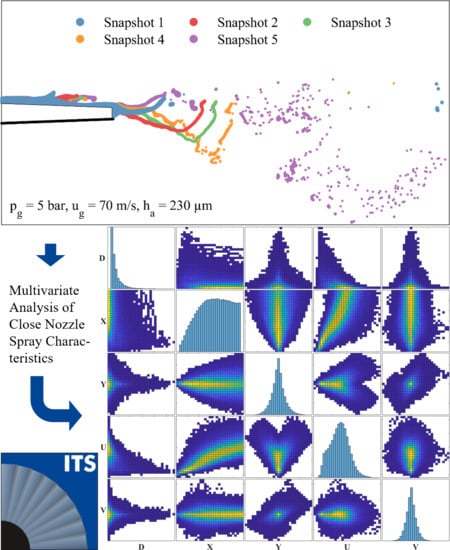Close Nozzle Spray Characteristics of a Prefilming Airblast Atomizer
Abstract
:1. Introduction
2. Numerical Method
3. Numerical Setup
3.1. Investigated Fuel Injector
3.2. Investigated Operating Conditions
3.3. Details of the SPH Setup
4. Results and Discussion
4.1. Characteristic Quantities and Sampling Procedure
4.2. Airflow Field
4.3. Phenomena Observed During Breakup
4.4. Analysis of the Ligament Evolution
4.5. Relations between Ligaments and Droplets
4.6. Analysis of the Spray Evolution
4.7. Effect of Gas Velocity and Prefilmer Geometry on the Spray Evolution
5. Conclusions
Supplementary Materials
Author Contributions
Funding
Acknowledgments
Conflicts of Interest
Appendix A. Non Dimensional Quantities
Appendix B. SMD-Correlation of Gepperth
References
- Lefebvre, A.H.; Ballal, D.R. Gas Turbine Combustion: Alternative Fuels and Emissions, 3rd ed.; CRC Press: Boca Raton, FL, USA, 2012. [Google Scholar]
- Gosman, A.D.; Ioannides, E. Aspects of Computer Simulation of Liquid-Fueled Combustors. J. Energy 1983, 7, 482–490. [Google Scholar] [CrossRef]
- Gallot-Lavallée, S.; Jones, W.; Marquis, A. Large Eddy Simulation of an ethanol spray flame under MILD combustion with the stochastic fields method. Proc. Combust. Inst. 2017, 36, 2577–2584. [Google Scholar] [CrossRef] [Green Version]
- Puggelli, S.; Paccati, S.; Bertini, D.; Mazzei, L.; Andreini, A.; Giusti, A. Multi-coupled numerical simulations of the DLR Generic Single Sector Combustor. In Proceedings of the Tenth Mediterranean Combustion Symposium, Naples, Italy, 17 September 2017. [Google Scholar]
- Comer, A.L.; Kipouros, T.; Cant, R.S. Multi-objective Numerical Investigation of a Generic Airblast Injector Design. J. Eng. Gas Turbines Power 2016, 138, 091501. [Google Scholar] [CrossRef]
- Keller, J.; Gebretsadik, M.; Habisreuther, P.; Turrini, F.; Zarzalis, N.; Trimis, D. Numerical and experimental investigation on droplet dynamics and dispersion of a jet engine injector. Int. J. Multiph. Flow 2015, 75, 144–162. [Google Scholar] [CrossRef]
- El-Asrag, H.A.; Iannetti, A.C.; Apte, S.V. Large eddy simulations for radiation-spray coupling for a lean direct injector combustor. Combust. Flame 2014, 161, 510–524. [Google Scholar] [CrossRef]
- Jones, W.; Marquis, A.; Vogiatzaki, K. Large-eddy simulation of spray combustion in a gas turbine combustor. Combust. Flame 2014, 161, 222–239. [Google Scholar] [CrossRef]
- Jaegle, F.; Senoner, J.M.; García, M.; Bismes, F.; Lecourt, R.; Cuenot, B.; Poinsot, T. Eulerian and Lagrangian spray simulations of an aeronautical multipoint injector. Proc. Combust. Inst. 2011, 33, 2099–2107. [Google Scholar] [CrossRef]
- Holz, S.; Chaussonnet, G.; Gepperth, S.; Koch, R.; Bauer, H.J. Comparison of the Primary Atomization Model PAMELA with Drop Size Distributions of an Industrial Prefilming Airblast Nozzle. In Proceedings of the 27th Annual Conference on Liquid Atomization and Spray Systems, Brighton, UK, 4–7 September 2016. [Google Scholar]
- Warncke, K.; Gepperth, S.; Sauer, B.; Sadiki, A.; Janicka, J.; Koch, R.; Bauer, H.J. Experimental and numerical investigation of the primary breakup of an airblasted liquid sheet. Int. J. Multiph. Flow 2017, 91, 208–224. [Google Scholar] [CrossRef]
- Volz, M.; Habisreuther, P.; Zarzalis, N. Correlation for the Sauter Mean Diameter of a Prefilmer Airblast Atomizer at Varying Operating Conditions. Chem. Ing. Tech. 2016. [Google Scholar] [CrossRef]
- Bilger, C.; Cant, S. Mechanisms of Atomization of a Liquid-Sheet: A Regime Classification. In Proceedings of the 27th Annual Conference on Liquid Atomization and Spray Systems, Brighton, UK, 4–7 September 2016. [Google Scholar]
- Braun, S.; Wieth, L.; Holz, S.; Dauch, T.F.; Keller, M.C.; Chaussonnet, G.; Gepperth, S.; Koch, R.; Bauer, H.J. Numerical prediction of air-assisted primary atomization using Smoothed Particle Hydrodynamics. Int. J. Multiph. Flow 2019, 114, 303–315. [Google Scholar] [CrossRef]
- Dauch, T.F.; Braun, S.; Wieth, L.; Chaussonnet, G.; Keller, M.C.; Koch, R.; Bauer, H.J. Computational Prediction of Primary Breakup in Fuel Spray Nozzles for Aero-Engine Combustors. In Proceedings of the 28th Conference on Liquid Atomization and Spray Systems, València, Spain, 6–8 September 2017. [Google Scholar] [CrossRef]
- Gingold, R.; Monaghan, J.J. Smoothed particle hydrodynamics: theory and application to non-spherical stars. Mon. Not. R. Astron. Soc. 1977, 181, 375–389. [Google Scholar] [CrossRef]
- Lucy, L.B. A numerical approach to the testing of the fission hypothesis. Astron. J. 1977, 82, 1013–1024. [Google Scholar] [CrossRef]
- Monaghan, J.J.; Kocharyan, A. SPH simulation of multi-phase flow. Comput. Phys. Commun. 1995, 87, 225–235. [Google Scholar] [CrossRef]
- Chaussonnet, G.; Braun, S.; Dauch, T.; Keller, M.; Sänger, A.; Jakobs, T.; Koch, R.; Kolb, T.; Bauer, H.J. Toward the development of a virtual spray test-rig using the Smoothed Particle Hydrodynamics method. Comput. Fluids 2019, 180, 68–81. [Google Scholar] [CrossRef] [Green Version]
- Hoefler, C.; Braun, S.; Koch, R.; Bauer, H.J. Modeling Spray Formation in Gas Turbines—A New Meshless Approach. J. Eng. Gas Turbines Power 2012, 135, 011503. [Google Scholar] [CrossRef]
- Wendland, H. Piecewise polynomial, positive definite and compactly supported radial functions of minimal degree. Adv. Comput. Math. 1995, 4, 389–396. [Google Scholar] [CrossRef]
- Wang, Z.B.; Chen, R.; Wang, H.; Liao, Q.; Zhu, X.; Li, S.Z. An overview of smoothed particle hydrodynamics for simulating multiphase flow. Appl. Math. Model. 2016, 40, 9625–9655. [Google Scholar] [CrossRef]
- Brackbill, J.; Kothe, D.; Zemach, C. A continuum method for modeling surface tension. J. Comput. Phys. 1992, 100, 335–354. [Google Scholar] [CrossRef]
- Adami, S.; Hu, X.; Adams, N. A new surface-tension formulation for multi-phase SPH using a reproducing divergence approximation. J. Comput. Phys. 2010, 229, 5011–5021. [Google Scholar] [CrossRef]
- Wieth, L.; Braun, S.; Koch, R.; Bauer, H.J. Modeling of liquid-wall interaction using the Smoothed Particle Hydrodynamics (SPH) method. In Proceedings of the 26th Annual Conference on Liquid Atomization and Spray Systems, Bremen, Germany, 8–10 September 2014. [Google Scholar]
- Braun, S.; Koch, R.; Bauer, H.J. Smoothed Particle Hydrodynamics for Numerical Predictions of Primary Atomization. In High Performance Computing in Science and Engineering’16; Springer Nature: Basingstoke, UK, 2016; pp. 321–336. [Google Scholar]
- Koch, R.; Braun, S.; Wieth, L.; Chaussonnet, G.; Dauch, T.; Bauer, H.J. Prediction of primary atomization using Smoothed Particle Hydrodynamics. Eur. J. Mech. B/Fluids 2017, 61, 271–278. [Google Scholar] [CrossRef] [Green Version]
- Dauch, T.; Braun, S.; Wieth, L.; Chaussonnet, G.; Keller, M.; Koch, R.; Bauer, H.-J. Computation of liquid fuel atomization and mixing by means of the SPH method: Application to a jet engine fuel nozzle. In Proceedings of the ASME Turbo Expo 2016: Turbine Technical Conference and Exposition GT2016, Seoul, Korea, 13–17 June 2016. [Google Scholar]
- Chaussonnet, G.; Gepperth, S.; Holz, S.; Koch, R.; Bauer, H.J. Influence of the ambient pressure on the liquid accumulation and on the primary spray in prefilming airblast atomization. arXiv 2019, arXiv:1906.04042. [Google Scholar]
- Gepperth, S.; Müller, A.; Koch, R.; Bauer, H.J. Ligament and droplet characteristics in prefilming airblast atomization. In Proceedings of the 12th Triennial International Annual Conference on Liquid Atomization and Spray Systems, Heidelberg, Germany, 2–6 September 2012. [Google Scholar]
- Gepperth, S. Experimentelle Untersuchung des Primärzerfalls an generischen luftgestützten Zerstäubern unter Hochdruckbedingungen. Ph.D. Thesis, Fakultät für Maschinenbau, Karlsruher Institut für Technologie, Karlsruher, Germany, 2018. [Google Scholar]
- Landahl, M.T.; Mollo-Christensen, E. Turbulence and Random Processes in Fluid Mechanics; Cambridge University Press: Cambridge, UK, 1992. [Google Scholar] [CrossRef]
- Pfaltz, J.L. Sequential Operations in Digital Picture Processing. J. ACM 1966, 13, 471–494. [Google Scholar] [CrossRef]
- Gepperth, S.; Koch, R.; Bauer, H.J. Analysis and comparison of primary droplet characteristics in the near field of a prefilming airblast atomizer. In Proceedings of the ASME Turbo Expo 2013: Turbine Technical Conference and Exposition, San Antonio, TX, USA, 3–7 June 2013. [Google Scholar]
- Holz, S.; Braun, S.; Chaussonnet, G.; Dauch, T.; Kaden, J.; Keller, M.; Schwitzke, C.; Koch, R.; Bauer, H.J. New Insights in the Primary Breakup Process of Prefilming Airblast Atomizers by SPH Predictions. In Proceedings of the 14th International Conference on Liquid Atomization and Spray Systems, Chicago, IL, USA, 22–26 July 2018. [Google Scholar]
- Braun, S.; Wieth, L.; Koch, R.; Bauer, H.J. Influence of Trailing Edge Height on Primary Atomization: Numerical Studies Applying the Smoothed Particle Hydrodynamics (SPH) Method. In Proceedings of the 13th Triennial International Conference on Liquid Atomization and Spray System, Tainan, Taiwan, 23–27 August 2015. [Google Scholar]
- Steinbach, A.; Dittmann, T.; Gerlinger, P.; Aigner, M.; Eggels, R. Soot predictions in an aircraft combustor at realistic operating conditions. In Proceedings of the ASME Turbo Expo 2018 Turbomachinery Technical Conference and Exposition GT2018, Oslo, Norway, 11–15 June 2018. [Google Scholar]
- White, F.M.; Corfield, I. Viscous Fluid Flow; McGraw-Hill: New York, NY, USA, 2006; Volume 3. [Google Scholar]

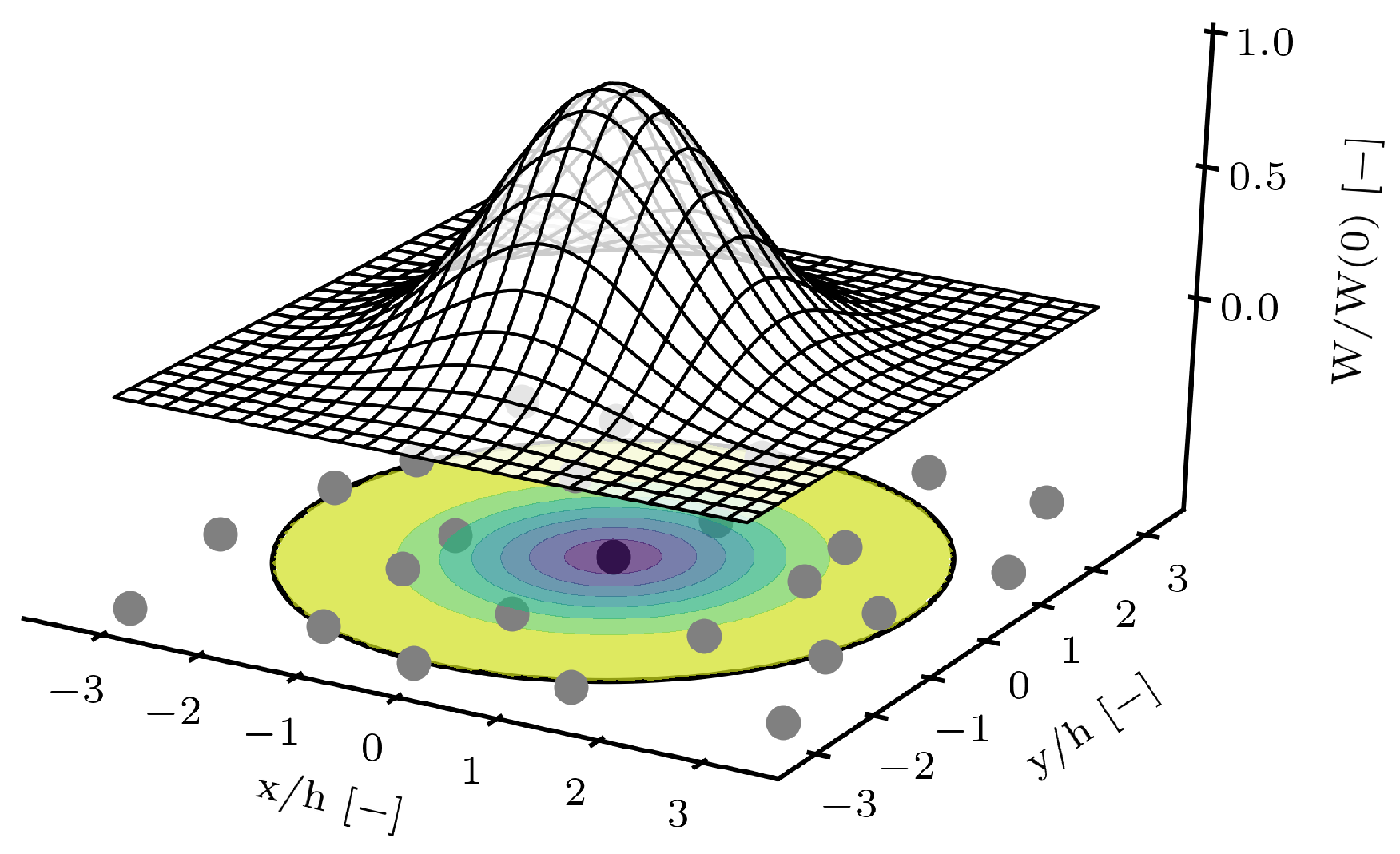

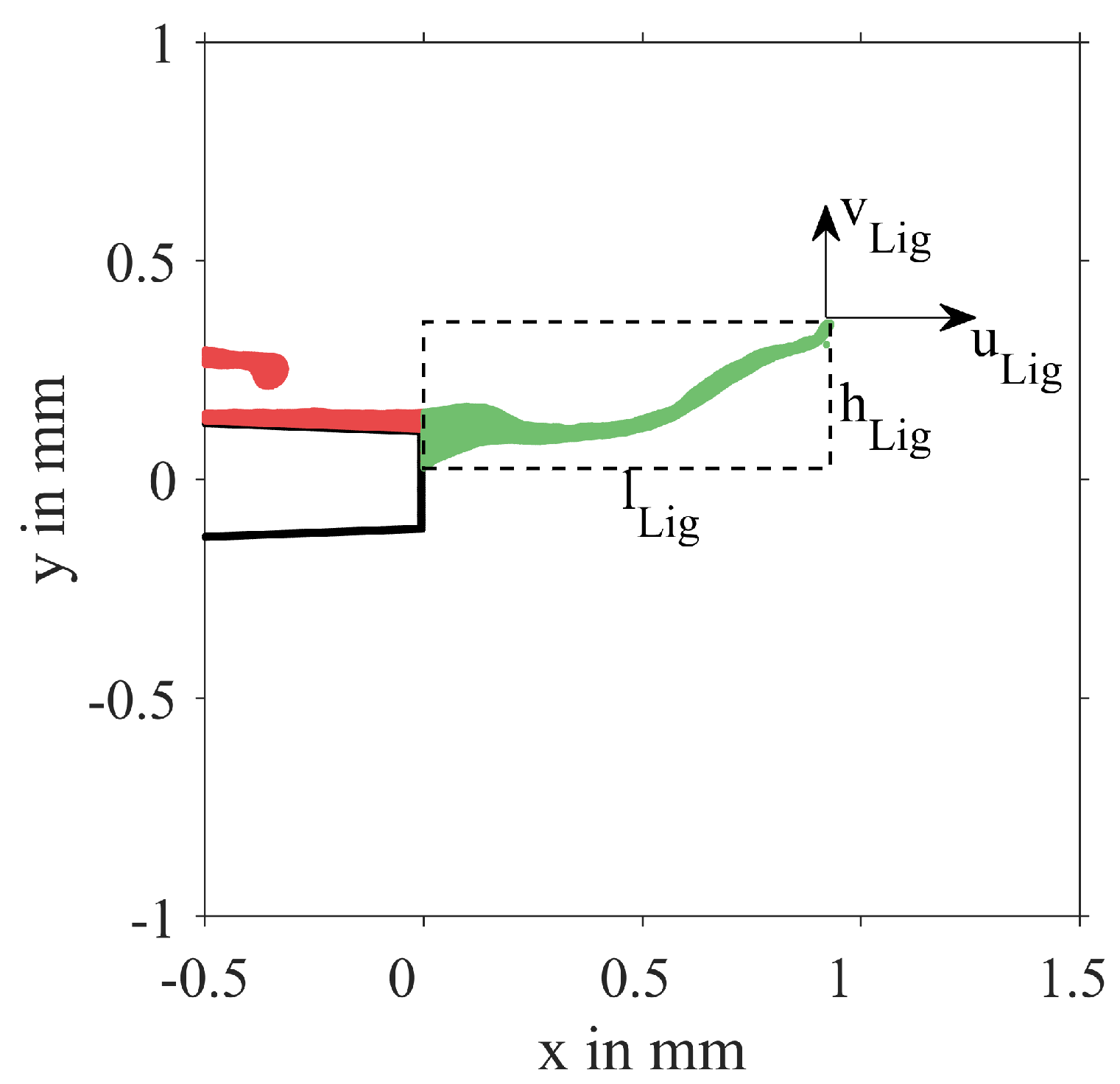
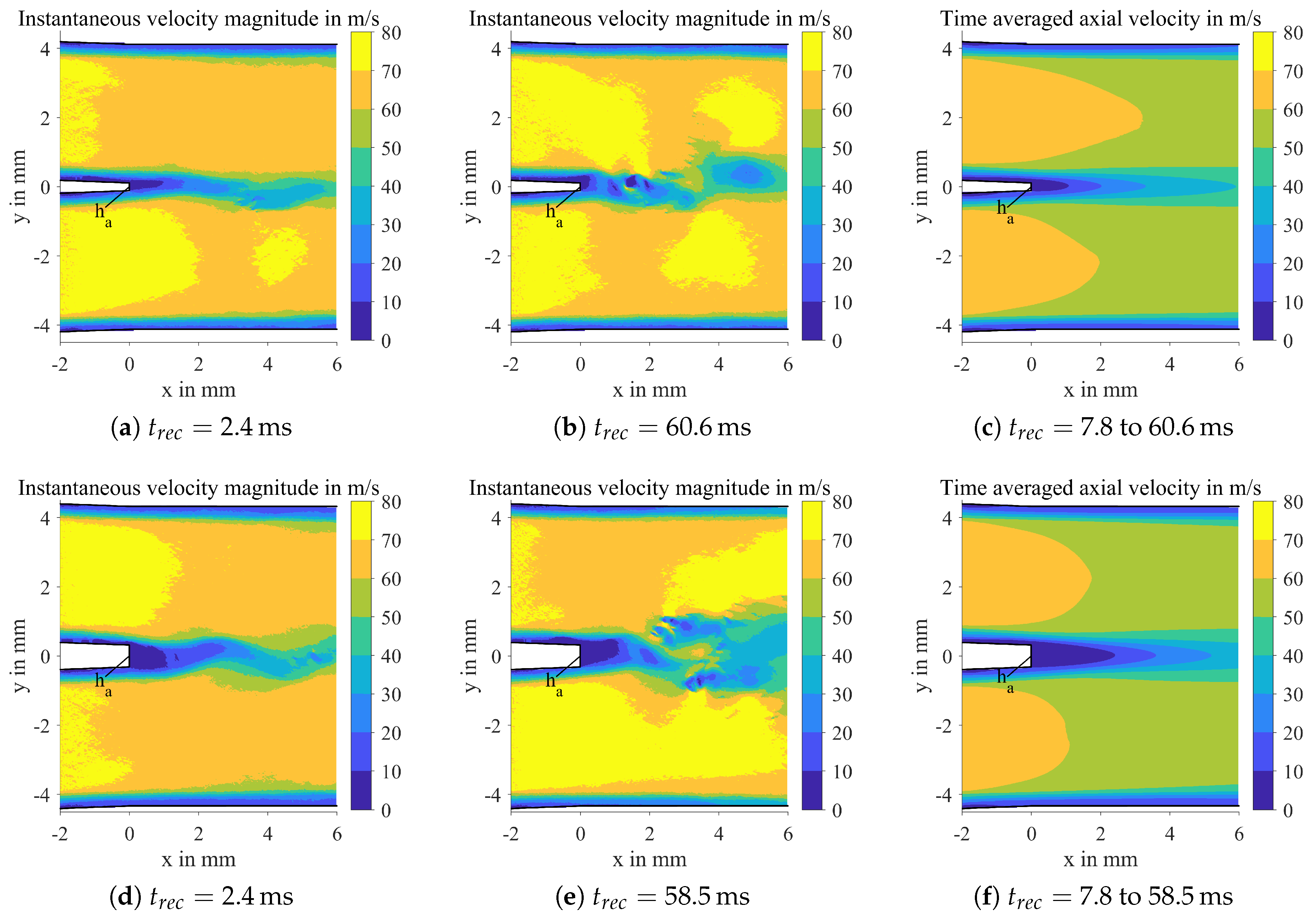

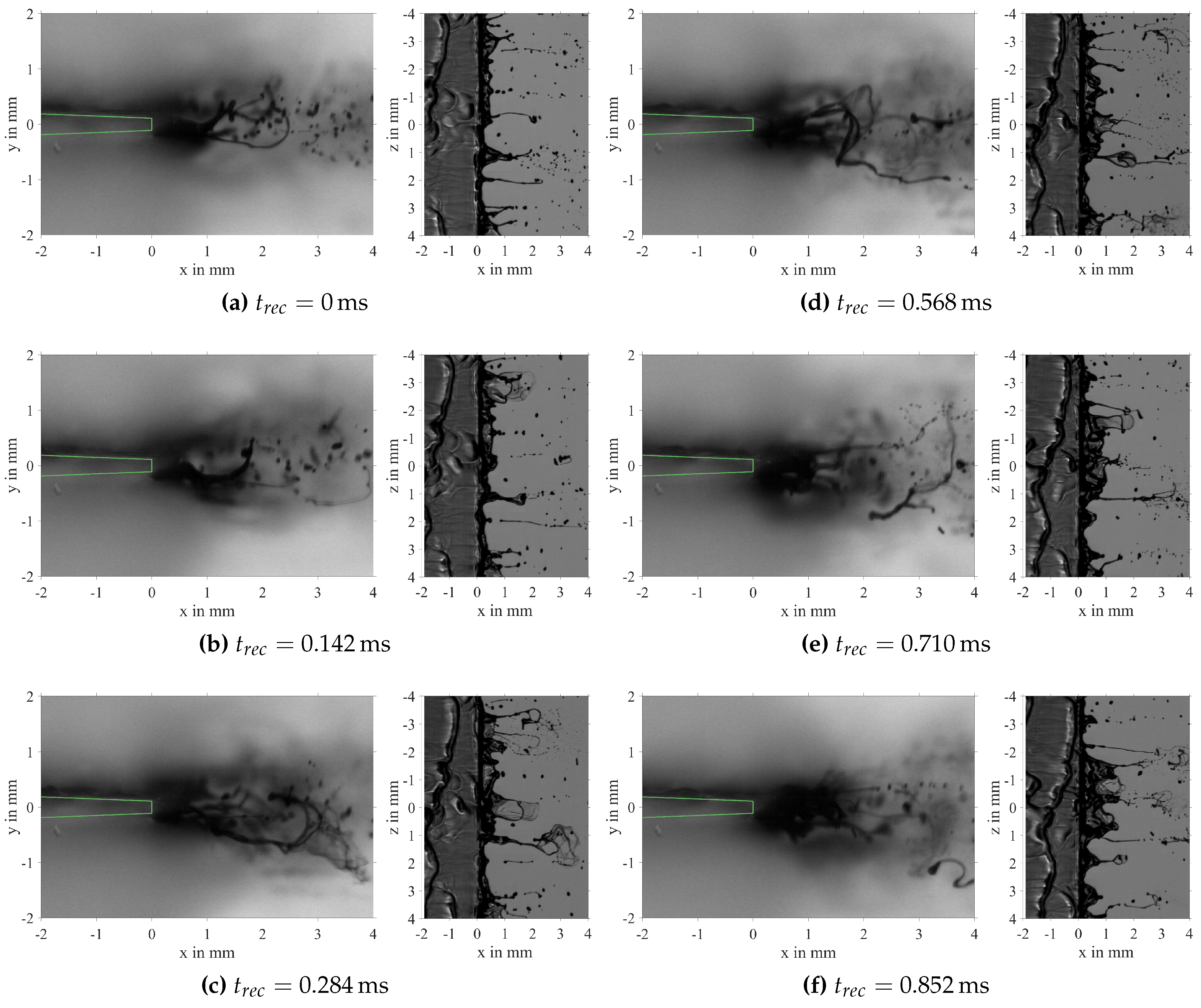
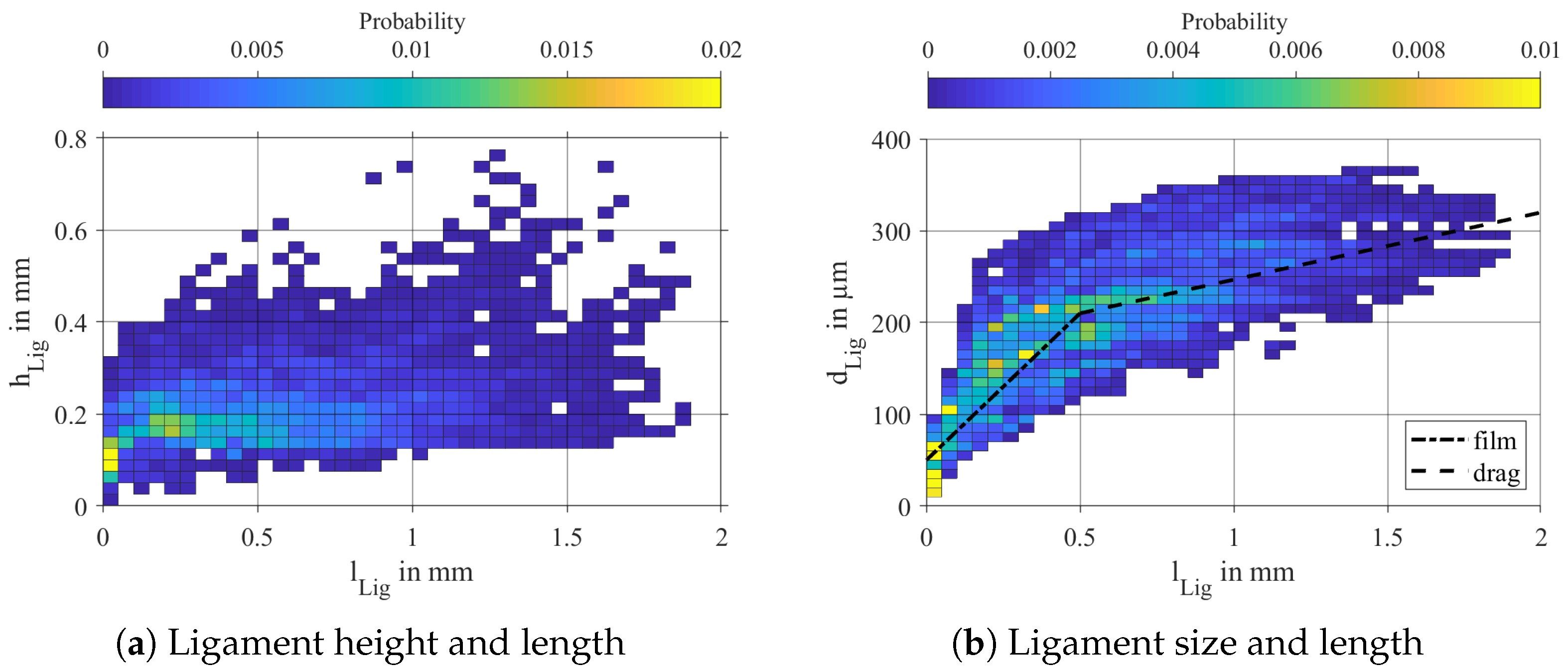
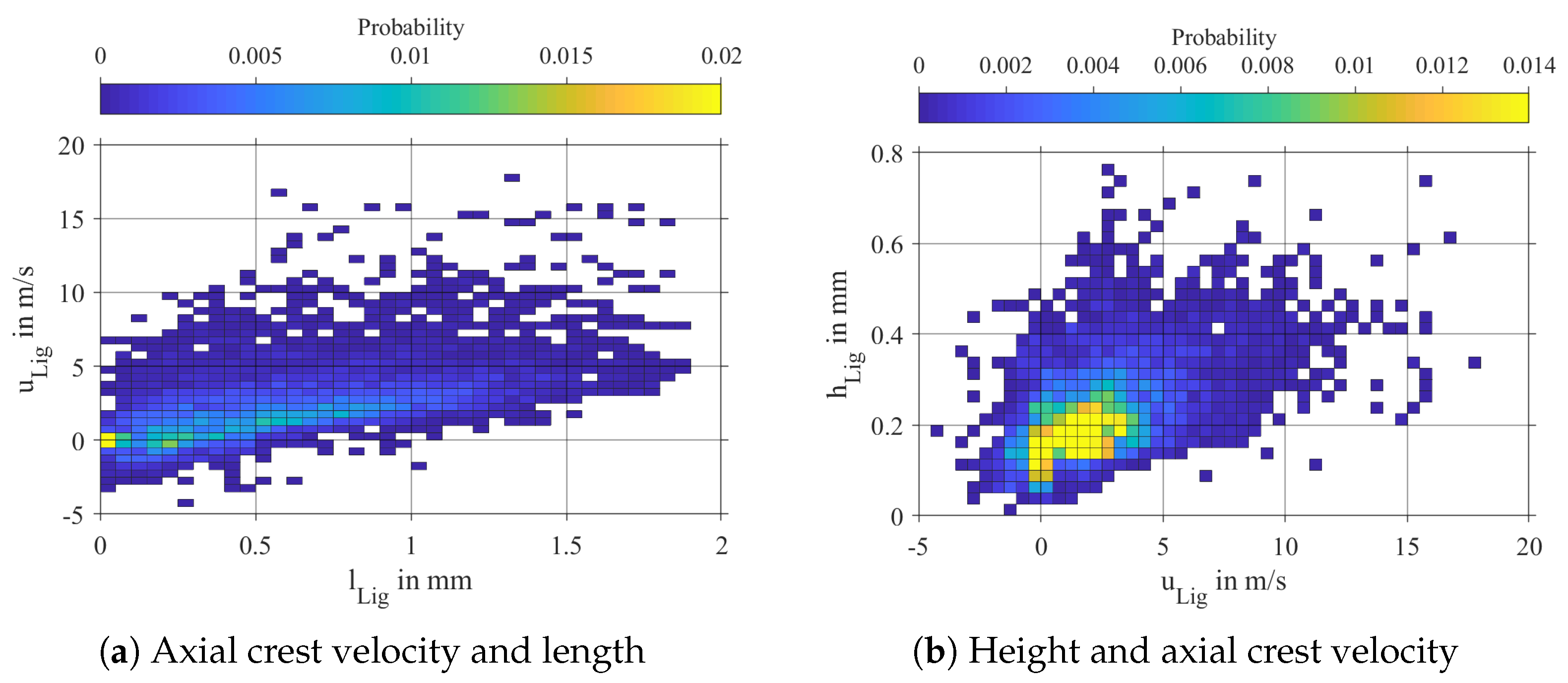
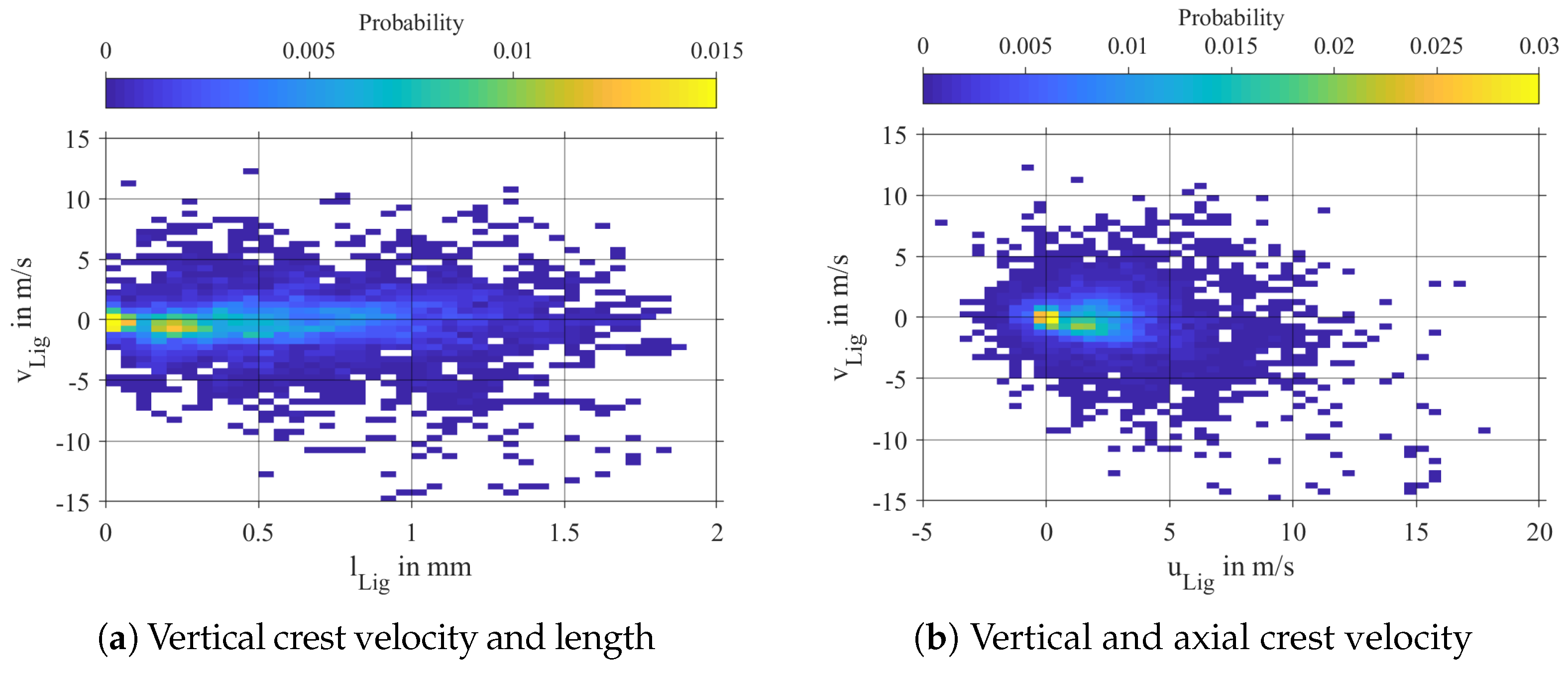
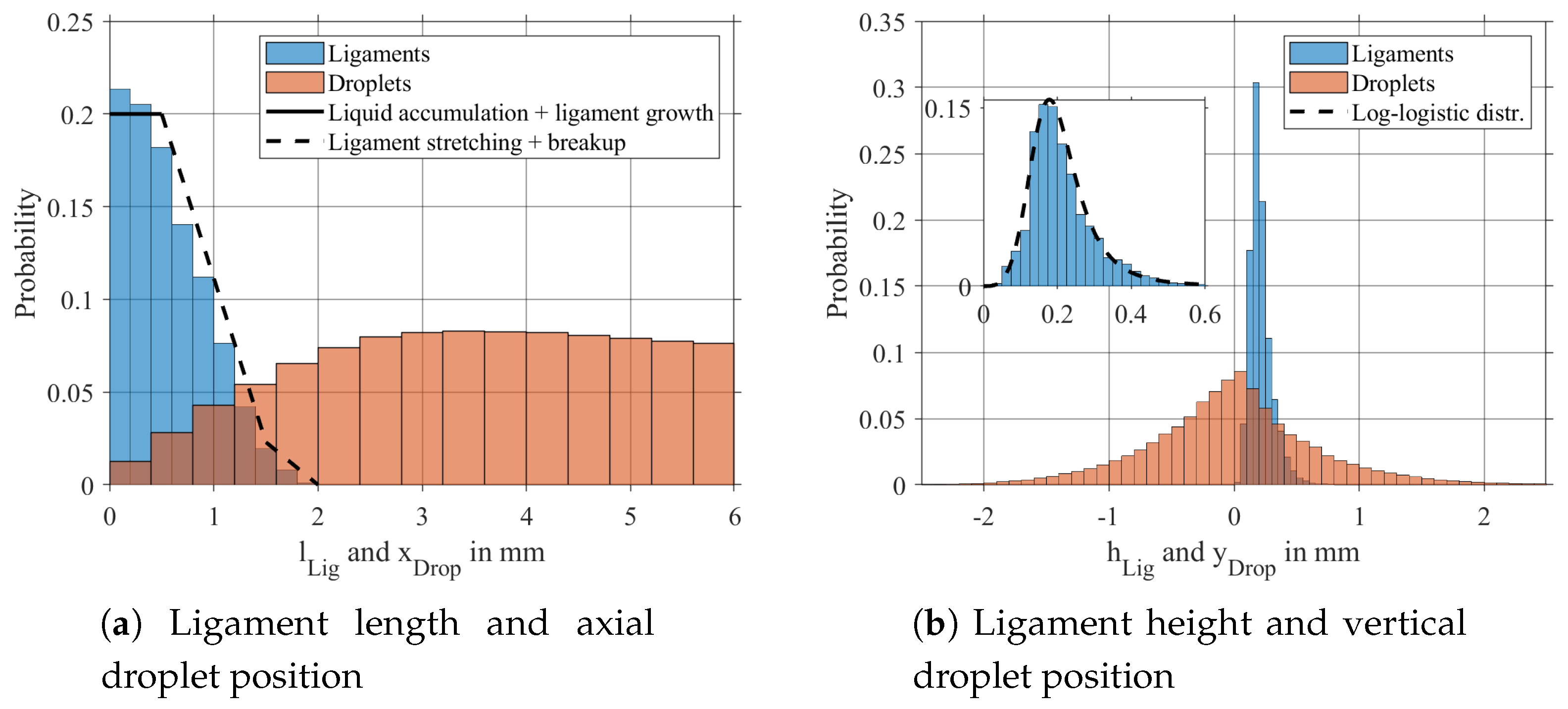
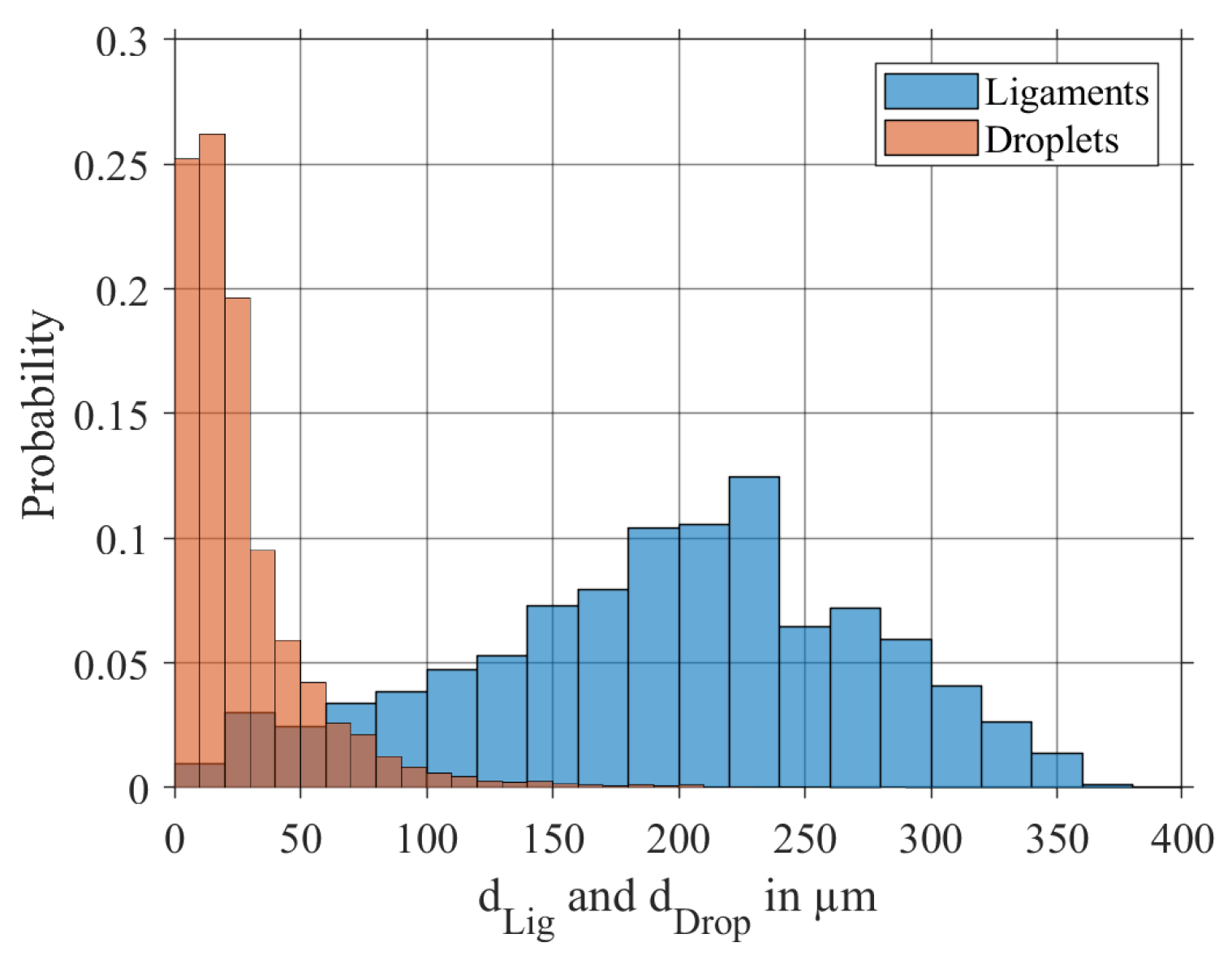
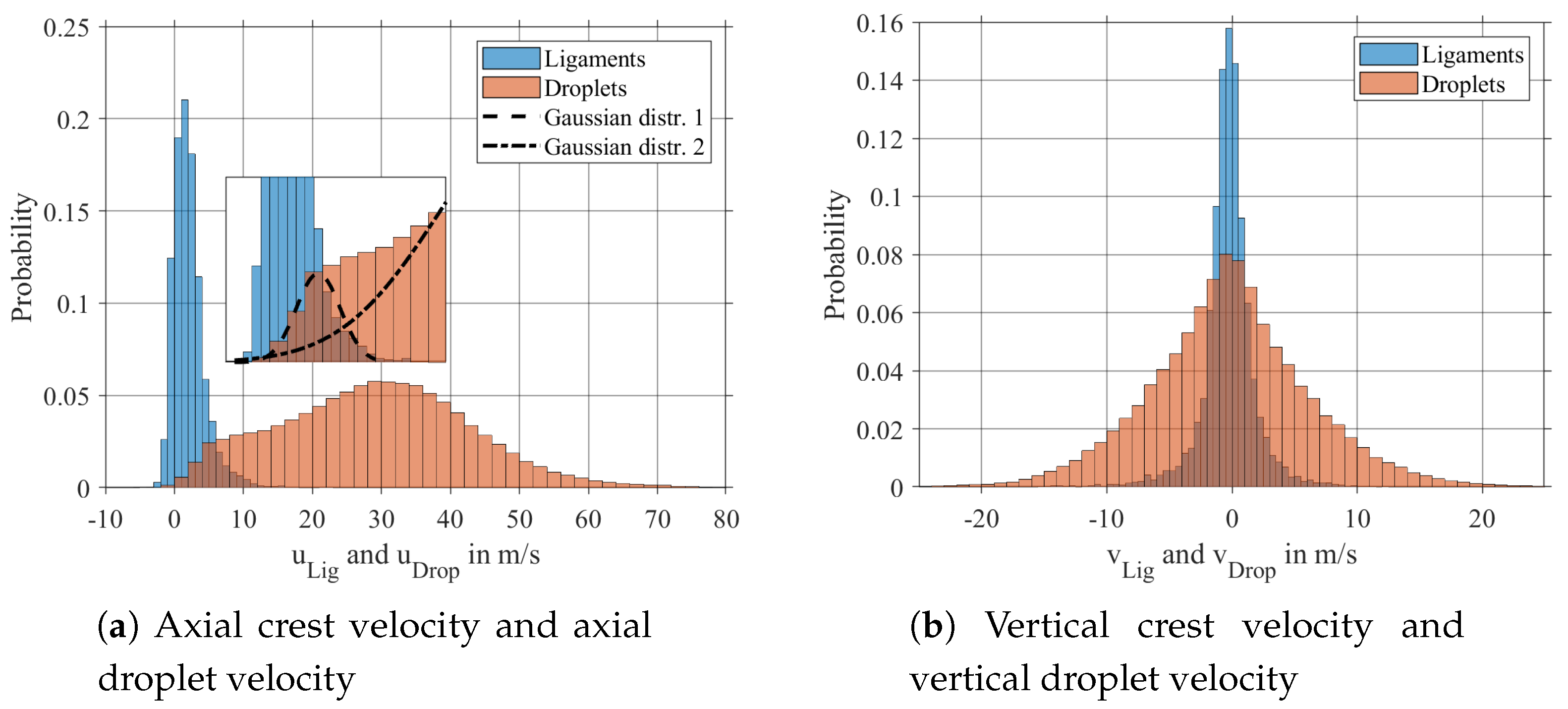
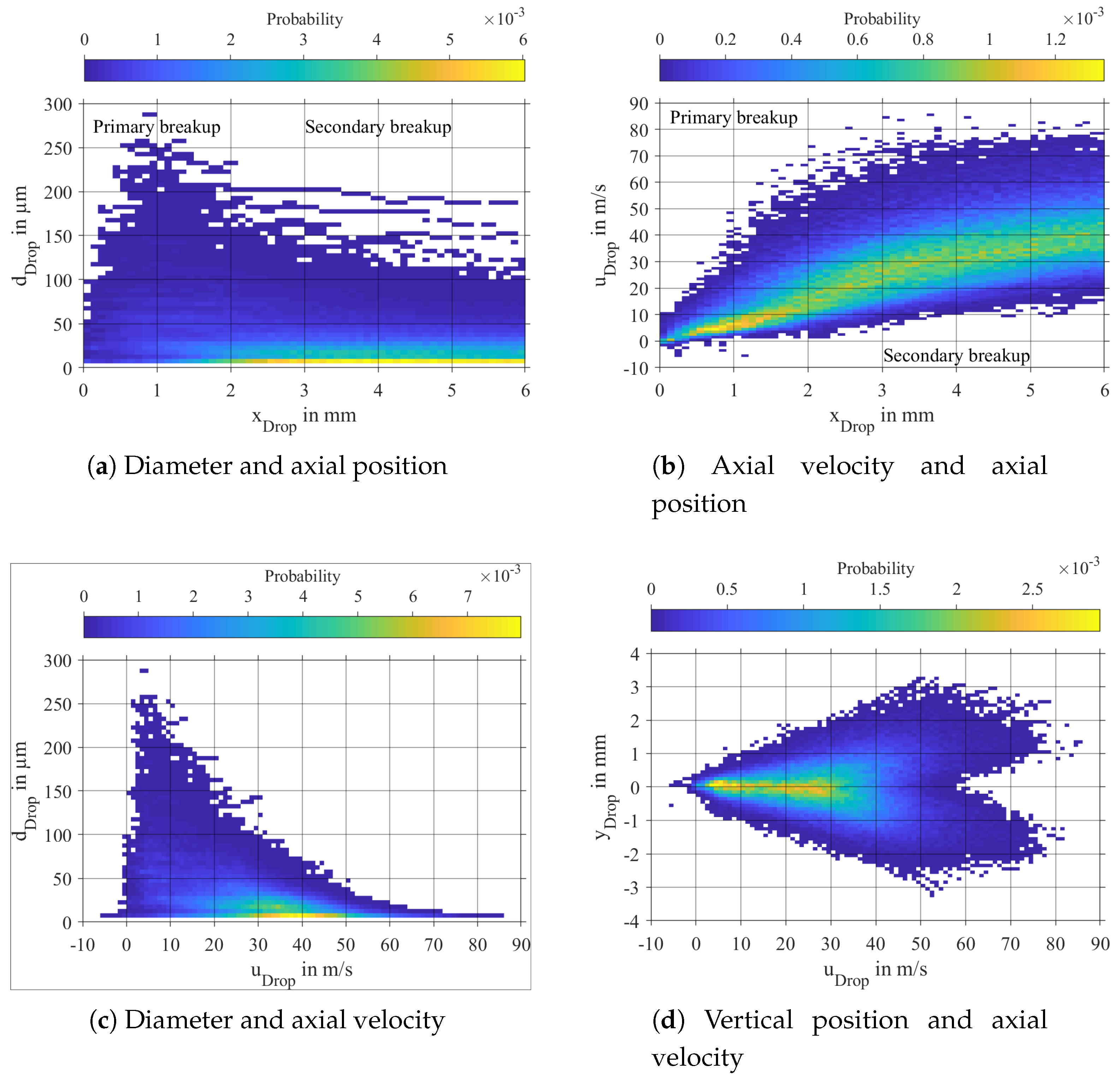
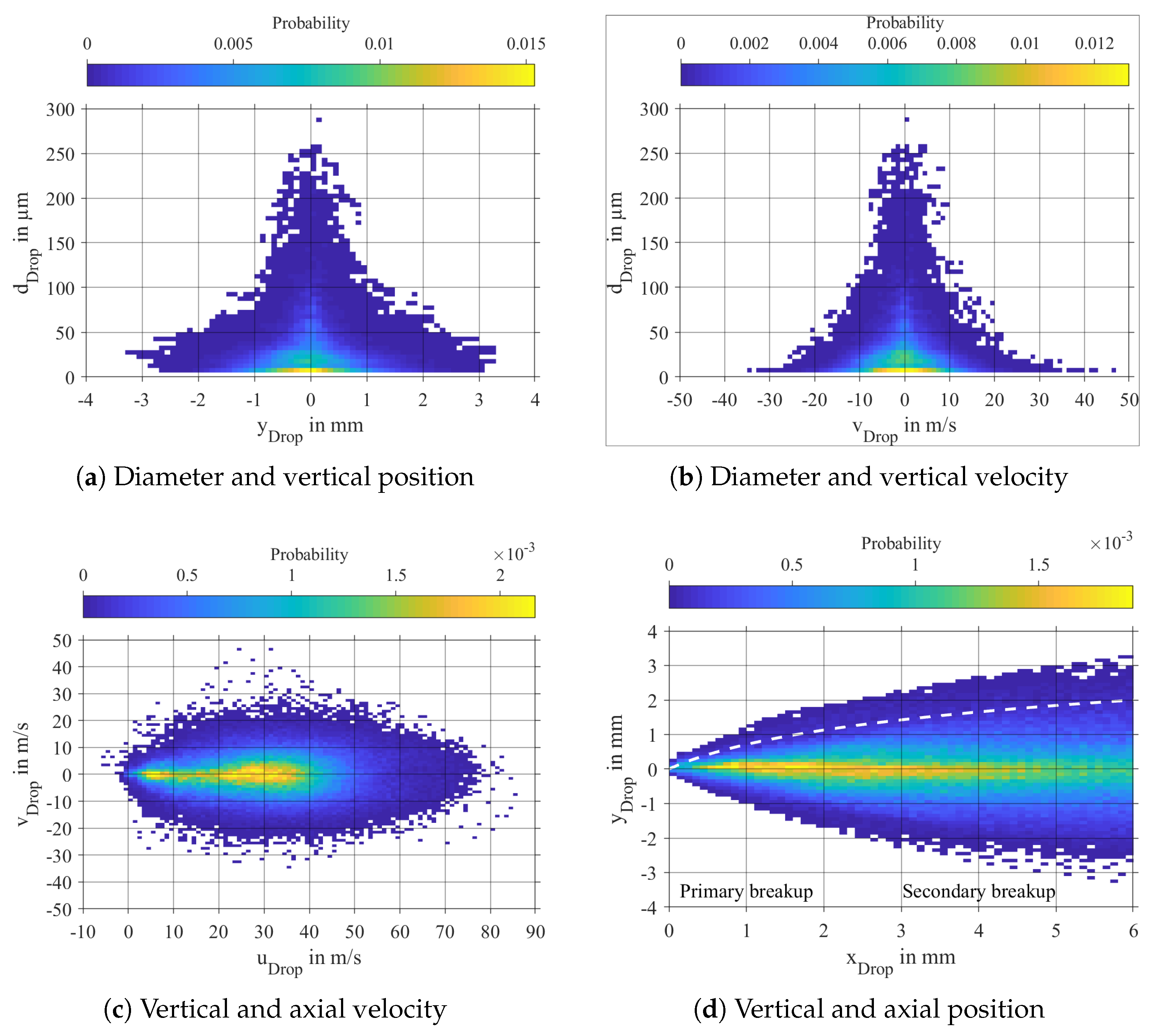
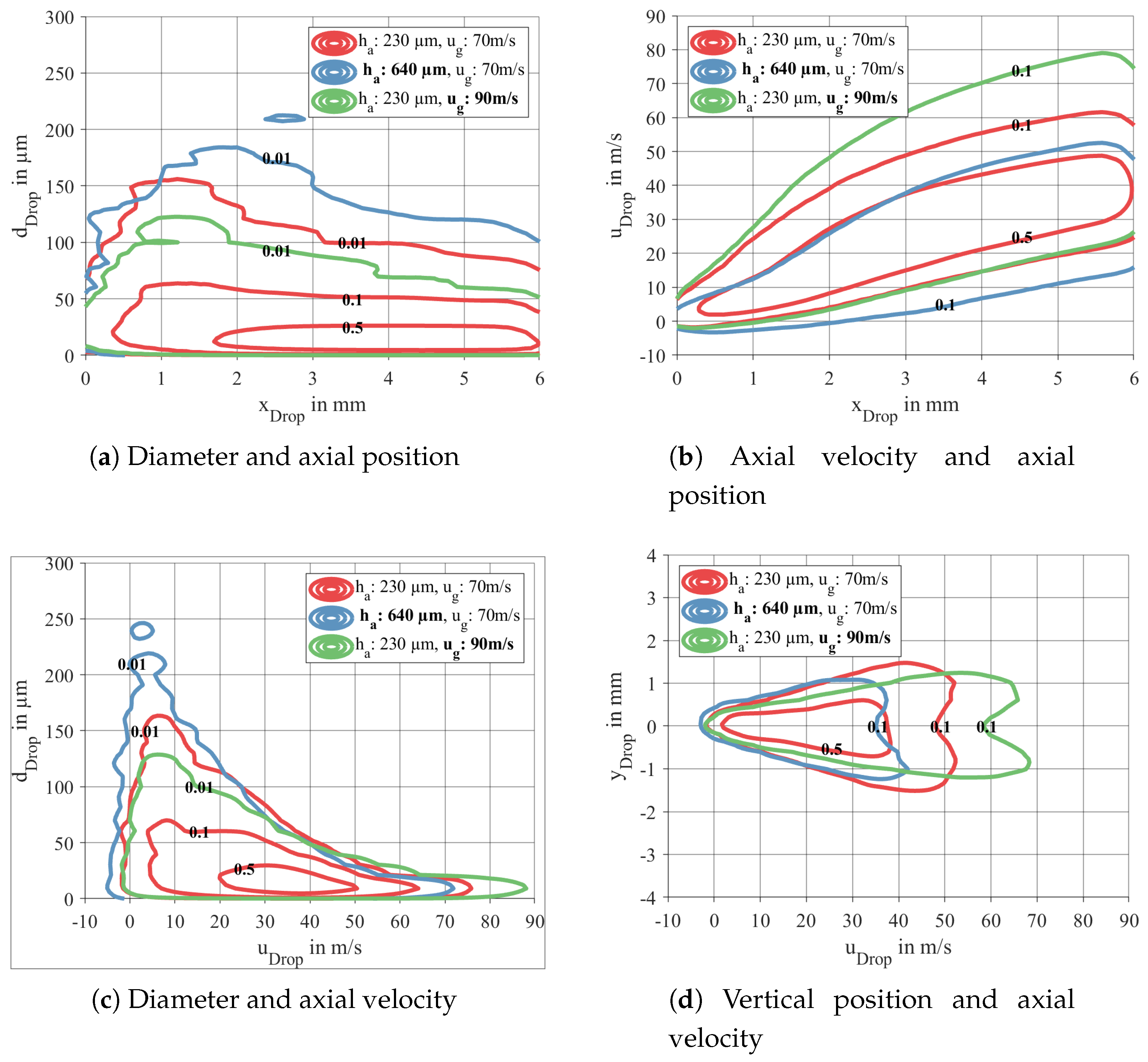
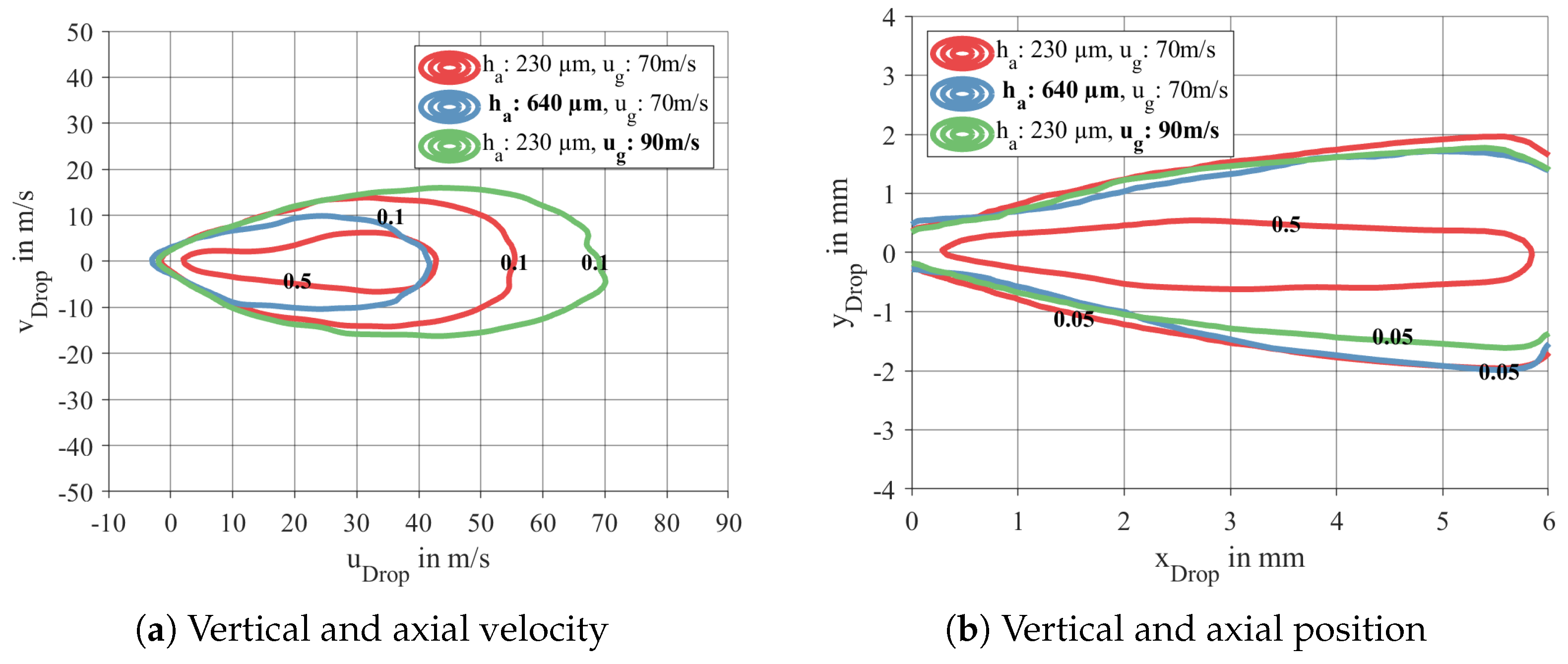
| Case | M | D | H | ||||||
|---|---|---|---|---|---|---|---|---|---|
| 1 | 230 | 70 | 5 | 27 | 154 | 16,852 | 1105 | 205 | 0.139 |
| 2 | 640 | 70 | 5 | 27 | 428 | 16,852 | 1105 | 205 | 0.387 |
| 3 | 230 | 90 | 5 | 45 | 254 | 20,902 | 1762 | 205 | 0.144 |
| units | μm | m/s | bar | - | - | - | - | - | - |
| Case | ||
|---|---|---|
| 1 | 66.0 | 69.3 |
| 2 | 94.7 | 96.2 |
| 3 | 57.9 | 55.5 |
| units | μm | μm |
© 2019 by the authors. Licensee MDPI, Basel, Switzerland. This article is an open access article distributed under the terms and conditions of the Creative Commons Attribution (CC BY) license (http://creativecommons.org/licenses/by/4.0/).
Share and Cite
Holz, S.; Braun, S.; Chaussonnet, G.; Koch, R.; Bauer, H.-J. Close Nozzle Spray Characteristics of a Prefilming Airblast Atomizer. Energies 2019, 12, 2835. https://doi.org/10.3390/en12142835
Holz S, Braun S, Chaussonnet G, Koch R, Bauer H-J. Close Nozzle Spray Characteristics of a Prefilming Airblast Atomizer. Energies. 2019; 12(14):2835. https://doi.org/10.3390/en12142835
Chicago/Turabian StyleHolz, Simon, Samuel Braun, Geoffroy Chaussonnet, Rainer Koch, and Hans-Jörg Bauer. 2019. "Close Nozzle Spray Characteristics of a Prefilming Airblast Atomizer" Energies 12, no. 14: 2835. https://doi.org/10.3390/en12142835




